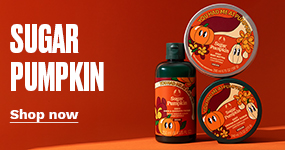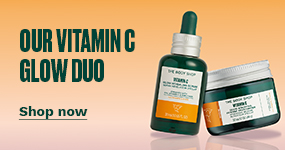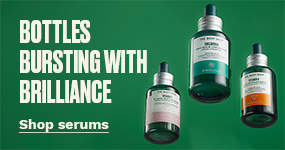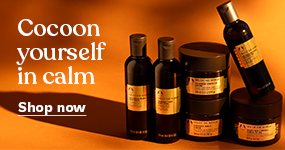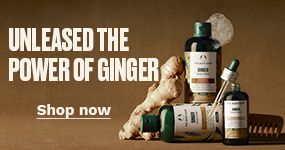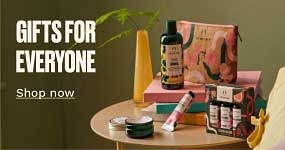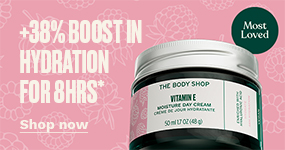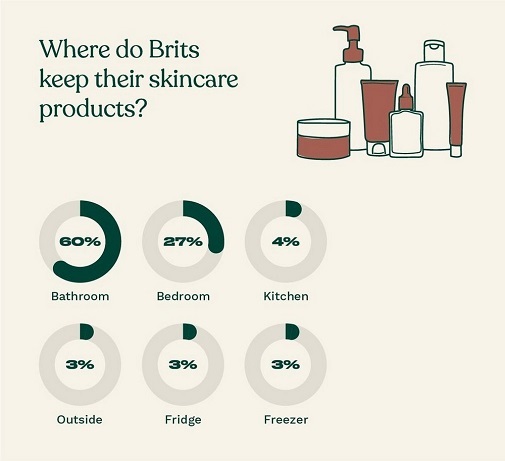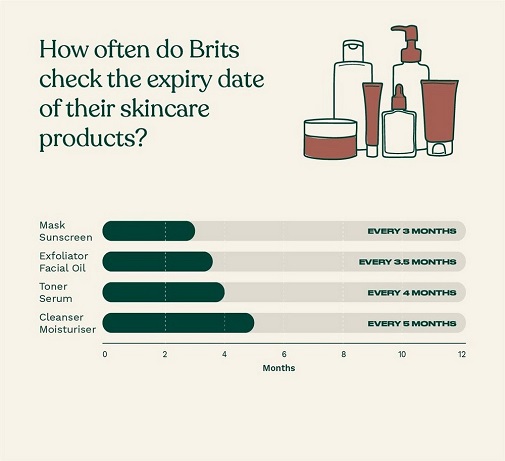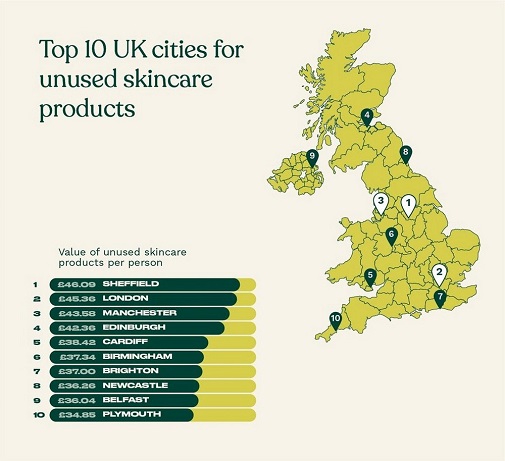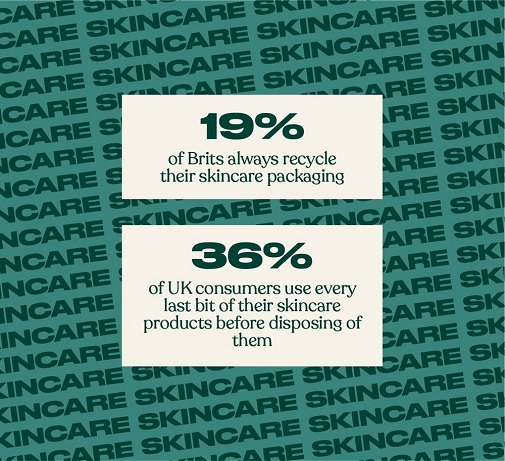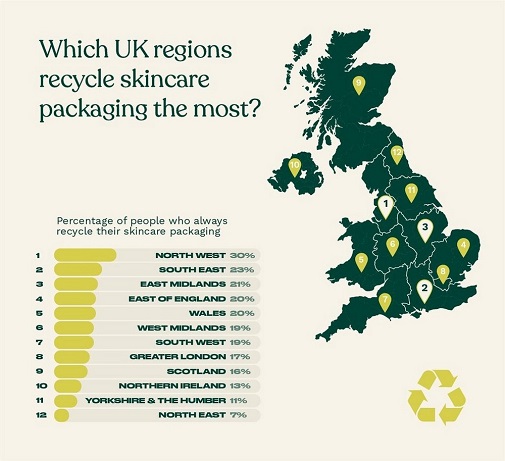SHAKE UP YOUR SKINCARE CABINET
At The Body Shop, we know that taking good care of your skin is super important (it's the largest organ in our body, after all). And, with around 70% of Brits regularly using skincare products, it seems that we're not alone!
However, taking care of your skin is one thing; taking care of your skincare products is another. Whether you've got your skincare routine nailed, or you're a newbie just starting to invest, the importance of regular maintenance for your products and tools can't be overestimated.
To delve into the topic further, we surveyed 2,000 UK skincare users on their product knowledge, habits and opinions. From bottle to bin (recycling bin, of course!) we wanted to find out just how skincare product savvy we are. We've looked at how best to store, keep and use our products to get the most out of them, whether that’s product hygiene, disposal or storage – you'll be surprised what we’ve discovered.
We’ve also recruited Dr Cynthia Bailey, MD to tell us exactly where we may be going wrong, and how to fix it. With 35 years of clinical experience, Dr Bailey is a Board-certified Dermatologist offering practical and professional skincare advice, making her skin-formation accessible to everyone.
So, does the nation need to shake up its skincare cabinet? And what’s the best way to go about doing it? Let's dive in.
SKINCARE STORAGE STATS
If we’re going to shake up our skincare cabinet, we thought we’d better start with the basics.
First up, storage. It’s probably not the first word you think of when it comes to your skincare, right? But aside from application, it’s one of the most important parts of ensuring your products are working properly. In fact, it can mean the difference between a product helping or hindering the skincare concerns you want it to combat in the first place.
Our research found that some of us have a lot to learn in this department.
When we surveyed UK skincare users, we found that 60% keep their products in the bathroom. While this makes practical sense for when you’re showering and washing, the rapid rise and fall of temperature and humidity in the bathroom can have a negative impact on the stability of your products, and their efficacy as a result.
Dr Bailey says: “Skincare products are designed to withstand the range of normal room temperature. Temperature extremes, including the freezer, the heat of direct sun or storage in a hot car will all impact product shelf life and stability. Skincare labelled as ‘preservative free’ will be particularly sensitive to degradation and microbial contamination under excessively hot conditions.
“Any product that was stored in extremes of temperature (beach bag/hot car/freezing holiday home during winter) should be discarded. The same goes for products stored in direct sunlight. Any product container that is really soiled and looks like it’s seen better days should also be disposed of. Start clean, mark containers after opening and have confidence that your skincare is safe and effective going forward.”


Dr Cynthia Bailey, MD
EXPIRY DATES
Expiry dates are also important for your skincare products. After all, when it comes to food, most of us wouldn’t dare ignore them, but our research found that we are generally more relaxed with our skin.
Around half (54%) of Brits are aware that skincare has an expiry date. However, of this group, 31% never get around to checking them. Most skincare products will only serve you well for up to a year before they should be written off, however, we found that 13% of our respondents are using at least one product that is more than 12 months old. Of course, that’s if you remember when you opened it!
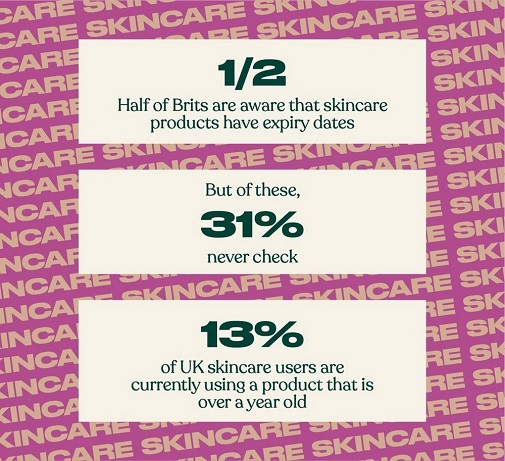

“Part of shaking up your skincare cabinet includes throwing out old products. Look at the expiration dates and throw out all expired sunscreens and medicated products. Any product that you opened greater than a year ago may also have gone bad,” advises Dr Bailey. “Formulations don’t last indefinitely, and germs grow in opened containers. 12 months is a good rule of thumb for skincare shelf-life PAO (period after opening); mark products with a permanent pen when you open them and discard them after 12 months.”
Clearly, with the increased risks of sun damage, irritation and even infection when using out-of-date products, you should make checking expiry dates a priority.
The product may also have a best before date which is a little easier to track. Few products will look, feel or smell out-of-date though, so it’s best to grab a pen and mark when you opened it to maintain that healthy complexion.
“It’s so important to check expiration dates on skincare. Products that are medicines and regulated by the FDA, such as sunscreens and acne medicines, will clearly list the date after which you should not use the product,” explains Dr Bailey. “The effectiveness of the active ingredients in these products cannot be guaranteed after the expiry date. Many skincare products don’t note expiration dates and you have to use your best judgement based on the storage conditions and what preservative systems are used in the product.”
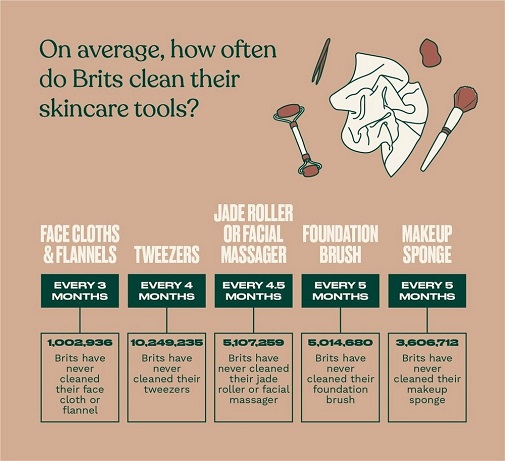

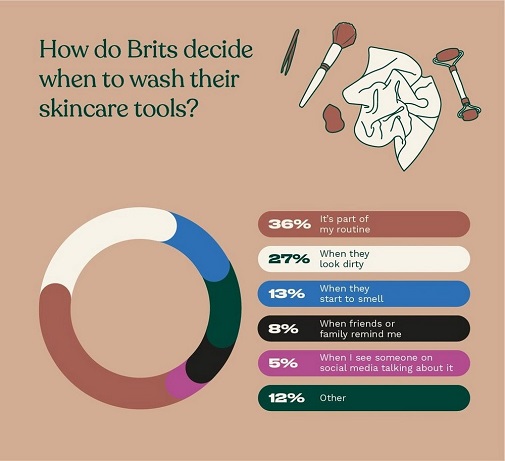

MAINTAINING YOUR SKINCARE SIDEKICKS
It’s a question that many of us will have asked ourselves: how often should we wash our makeup brushes? The answer is often! What’s more, any tools you’re using as part of your skincare routine - whether to remove your makeup, cleanse your face or generally do some grooming - also need to be clean. From jade rollers to tweezers, face cloths to sponges, keeping skincare tools clean should be a priority. Here’s why.
FACE CLOTHS
We found that, despite the average UK skincare user cleaning their face cloth every three months, more than a million Brits (1,002,936 to be precise!) have never cleaned their face cloth or flannel.
It may seem like your cleanser is doing a good enough job but wiping away the excess with a cloth can help to remove the excess oils left over. If these aren’t clean to start with, you are simply re-wiping your clean face with dirt.
“Face cloths should be washed at a minimum of weekly – and more if heavy oil and product residue build up,” says Dr Bailey. “Many of today’s skincare products don’t rinse off easily and will build up on the cloth. A damp cloth with product residue, oil, and dead skin cells (aka protein) is an ideal environment for bacteria. Plus, you can’t get your skin clean by massaging it with a dirty wet cloth. If the cloth rings clean after use, is hung up and stored in a manner where it entirely dries between use, then once weekly washing is what I would recommend. If the cloth is visibly soiled and/or not dry between uses, I recommend pulling a clean cloth from the cabinet and starting fresh. Bacterial folliculitis, or an inflammation of the hair follicle, often requires antibiotics to treat and may lead to scarring.”
MAKEUP BRUSHES
We also asked how often respondents clean their makeup brushes and discovered that over five million (5,014,680) Brits have never cleaned their foundation brush. Makeup brushes used for cream-based products are prone to build-up from skin oil, product residue and pigment from makeup – far quicker than that of powdered products. So, it’s vital to keep them clean.
Dr Bailey advises you to clean them at least once a month. She says: “Ideally, if you use your makeup brush daily, I would clean it every other week. Also, never share your makeup brush – your skin flora is personal and someone else may harbour microbes that cause your skin to break out.”
MAKEUP SPONGE
Although it may feel like a chore, and the kind of thing that will always drop to the bottom of your to-do list, makeup sponges are no exception. In fact, these should be cleaned more than your brushes to avoid blending in any bacteria.
“Makeup sponges that are wet before use need to be rinsed clean with soap and water and left to dry entirely between uses,” says Dr Bailey. “Bacteria will flourish in a damp sponge and may lead to infection.” Damping sponges before use acts as a cosy breeding ground for bacteria so if you’re one of the 3,606,712 Brits that have never cleaned their makeup sponge, aim to do so very soon.
TWEEZERS
Tweezers are the one applicator we may not think about being dirty. How can plucking a few hairs every now and then become a hygiene issue? Well, 10,249,235 Brits that have never cleaned their tweezers, and if you’re one of them, you might want to listen up.
“Epilating tweezers (used strictly to remove hair) should be washed with soap and water then rinsed with rubbing alcohol when they appear soiled or contain debris and oil,” advises Dr Bailey. “They should always be stored in a clean location that allows them to dry entirely between uses. Any corrosion will harbour debris, oil, moisture and dead skin cell debris that will create a resort for bacteria – leading to bacterial folliculitis.”
JADE ROLLERS
Finally, jade rollers (also called Gua Sha) and facial massagers. We found that, on average, Brits only clean these every 4.5 months. Any mechanical object that touches your face should be clean – that includes your jade roller or even non-skincare items such as your sunglasses nose piece.
Dr Bailey suggests, “If you only use your jade roller on freshly cleansed skin, you won’t need to wash it as often. If, however, you use it on skin that has makeup, sunscreen, a day’s worth of oil and exfoliating dead skin cells then you will need to wash it far more frequently.”
HOW TO CLEAN BEAUTY TOOLS?
All the above skincare tools can be cleaned with soap and warm water, aside from your makeup brushes which should be lathered and rinsed with shampoo. Simply wipe with your hands or a cloth, then leave to air dry.
AVOID PRODUCT WASTING
When it comes to skincare, we want you to get the most out of your products – but we understand that finding what works for you as an individual can be hard. After all, our research suggests that only a quarter of us feel confident we know what works for our skin.
It's therefore not surprising that so many of us buy skincare products with the aim of incorporating them into our routine, only to end up finding they're not quite right, and dumping them back in the cupboard as a result.
But why do we abandon our skincare products? And how much could this be costing us in the long run?
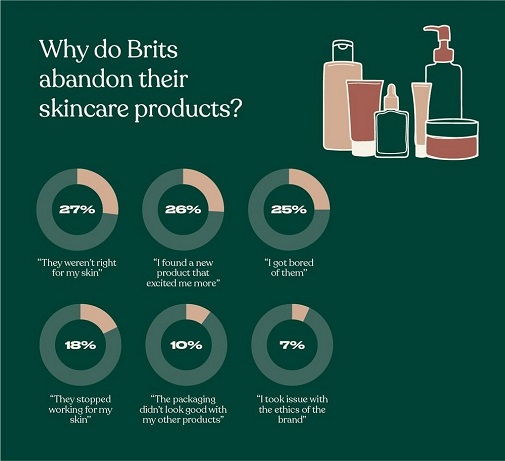

Perhaps unsurprisingly, around a quarter of skincare products are abandoned because the formulation simply wasn’t right for that person’s skin from the get-go. Or perhaps they initially worked but later fell flat. We found many of us are motivated by novelty, with 26% of us ditching skincare products because we found something newer and more exciting.
What about our skincare product aesthetic? Well, it seems that one in 10 Brits are taking this pretty seriously and would stop using a skincare product if it didn’t fit with the look and feel of their existing routine.
Lastly, some of us would abandon a product if we later found out that the ethics of the brand weren’t up to scratch.
WHAT'S THE COST OF ABANDONED SKINCARE PRODUCTS?
For obvious hygiene reasons, skincare that has already been opened cannot be returned and used again by somebody different. So, for many of us, once we have decided to no longer use a skincare product, we end up hanging onto it.
To look into this further, we decided to find out the value of unused skincare that we all have sitting in the back of a cupboard. The results may surprise you!
Our findings show that UK skincare users spend on average £17.51 on each skincare product, and currently has two unused, unopened, or abandoned products sat at the back of their cupboard. That’s an average of £35.02 per person.
Across the UK, this equates to over £1 billion in abandoned skincare products – a huge amount, we’re sure you agree.
We also used this calculation to look at which UK cities have the biggest problem when it comes to unused skincare products. Sheffield, London, and Manchester take the top three spots, with each person sitting on £46.09, £45.36 and £43.58 worth of unused products, respectively.
HOW TO CHOOSE THE RIGHT SKINCARE PRODUCTS?
Avoiding skincare abandonment comes down to one key thing: getting it right the first time round. If you struggle with this (let’s be honest, many of us do!) try our routine builder to work out what you want from a product and help ensure you pick the right one for you.
Why not also swap or gift your unused products to friends and family who may find they work better for their skin?
We asked Dr Bailey for her advice on how to find a streamlined range of products that work for you. She says: "I like to keep skincare simple with four steps: a Cleanse Correct Hydrate ProtectTM routine.”
STEP 1 : CLEANSE
A key concern here is that your cleanser matches your skin type (gentle for sensitive skin, normal for all others). You may also want to include a second cleanse with a toner to remove additional residue and debris . You can shop our cleansers and toners here.
STEP 2 : CORRECT
Correcting products (such as serums and creams with high concentration actives or medicines) address skin problems such as blemishes, sensitivity, sun damage etc. They should be applied to freshly clean skin . Shop our serums.
STEP 3 : HYDRATE
Hydrating products are moisturisers with barrier enriching ingredients like oils or ceramides. Occasionally correcting products or protecting products may be formulated in a base that also acts as a moisturiser to keep your skin barrier healthy . Explore our moisturisers.
STEP 4 : PROTECT
This means sun protection SPF 30 or higher during the day. Makeup, if worn, should be applied on top.Additional products such as masks, mists, scrubs, peels, and derma-rollers can be used intermittently based on your complexion's needs and your goals . Discover skincare with SPF here.
RECYCLE YOUR BEAUTY PRODUCTS
At The Body Shop, we’re fighting for a fairer, more beautiful world for us all to live in, and reducing our impact on the environment is a key part of this. As an industry, and a nation, there’s no denying we need to do more to reduce waste. However, we found that only one in five of us always recycle our skincare packaging. And two-thirds of us will dispose of product packaging before the entire contents have been used up. Over a lifetime, this means we could be consuming far more products than we actually use.
WHICH UK REGIONS RECYCLE SKINCARE PACKAGING THE MOST?
We also looked at which UK regions perform best when it comes to recycling their skincare packaging. We found that the North West is the most skincare recycling-savvy, with 30% of respondents saying that they always recycle their packaging. This is followed by the South East and East Midlands. Clearly, we’re making strides, but we know that the problem won’t be solved overnight. It’s up to brands to continue their great work in creating innovative new packaging and recycling solutions, which will allow us all to recycle more in the future.
HOW TO RECYCLE SKINCARE BOTTLES & PACKAGING
At home: many items come in glass, plastic and cardboard packaging so try to recycle as much as you can at home. Larger single material items can be recycled at home like glass and plastic jars, plastic bottles and aluminium packaging, as well as gift packaging made of card.
At the Body Shop, we recently introduced a nationwide recycling scheme, which aims to make the process more straightforward. If you’re struggling with where to recycle your pumps, mascaras and pipettes, drop them in your local store using our Return.Recycle.Repeat initiative. It’s a super convenient way to bring back hard-to-recycle items that are rejected from curb-side recycling, and to do your bit for the planet.
SUMMARY
At The Body Shop, we pride ourselves in providing highly effective skincare products suitable for a wide range of skin types, without compromising people or the planet.
In shaking up your skincare cabinet, it’s important to not only ensure the health of your skin, but also the environment, and not to forget your purse too.
Remember, no matter your skincare concerns it’s always nice to take care of yourself. Why not treat yourself and go all out with a spa pamper session after your productive decluttering session. Nothing says self-care like a face mask.
METHODOLOGY AND SOURCES
We surveyed 2,000 UK adult skincare users on their skincare knowledge and habits. The research was carried out April 2022.
For exact figures, we took the total percentage of skincare users across the UK vs the total number of UK adults and calculated this breakdown as a whole number.
At the time of research, there were 55,106,377 adults in the UK population. 70% of people buy skincare products at least once per month. From this, we estimate that a total number of 38,574,464 adults are currently regular skincare users in the UK.



